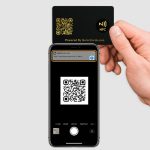Yes, plastic discount cards can be customized with barcodes, QR codes, and other tracking technologies. This transforms simple promotional items into powerful business tools that enhance customer engagement and program management.
Adding barcodes or QR codes creates numerous possibilities beyond basic identification. Point-of-sale systems can instantly apply discounts, track loyalty points, or verify membership status. Mobile apps can scan QR codes to deliver personalized offers directly to customers’ smartphones.
Implementing coded custom discount cards has become increasingly accessible for businesses of all sizes. Card manufacturers now offer streamlined production with fully functional codes that integrate with most business systems.
How Barcodes and QR Codes Work on Plastic Cards?
Barcodes and QR codes function as visual data representations that connect physical cards to digital systems. When added to plastic discount cards, they create a bridge between the card and your management software.
Types of codes commonly used on cards:
- Traditional barcodes: Parallel lines storing 8-15 characters
- QR codes: Square patterns storing several thousand characters
- Data Matrix: Compact 2D codes for limited space applications
- PDF417: High-capacity stacked barcodes
For reliable scanning, codes require:
- Sufficient contrast (typically black on white)
- Appropriate size (generally at least 0.5 inch)
- Adequate margin space around the code
- High-resolution printing (minimum 300 DPI)
QR codes offer more versatility with their ability to store URLs, contact information, and other complex data. This makes them ideal when you want customers to access specific digital content through their smartphones.
Types of Codes Used on Discount Cards
Different code formats work well for specific applications on discount cards:
Linear barcodes remain popular for retail and service businesses due to their universal compatibility with standard scanning equipment. These simple codes excel in situations where cards are primarily scanned at fixed locations by staff members. They integrate easily with most point-of-sale systems and require minimal technical setup, making them ideal for small to medium businesses just starting with coded cards.
Two-dimensional codes like QR and Data Matrix offer more sophisticated capabilities. These formats can store significantly more information in a similar space and support direct encoding of contact details or website links. They’re particularly valuable for programs that include both physical and digital components, as customers can scan these codes with their smartphones to access online content or special offers.
Common usage scenarios:
- Retail loyalty: 1D barcodes for simple member identification
- Restaurant rewards: QR codes for mobile app integration
- Membership clubs: Magnetic stripes for secure access
- Healthcare discounts: Data Matrix codes for privacy
Many businesses combine multiple technologies on a single card. For example, a card might feature a QR code for mobile interactions and a barcode for in-store systems, creating versatility across all customer touchpoints.
Benefits of Adding Codes to Plastic Discount Cards
Coded discount cards offer significant advantages for both businesses and customers.
Business benefits include:
- Faster checkout with automatic discount application
- Reduced errors compared to manual discount entry
- Simplified program tracking and analytics
- Ability to update offers without issuing new cards
- Enhanced data collection for marketing insights
- Better security and fraud prevention
- Integration with inventory and POS systems
Customer advantages:
- Consistent application of deserved discounts
- No need to mention or remember promotional offers
- Faster service at checkout
- Easy access to benefits across multiple locations
- Potential for personalized offers based on purchase history
When properly implemented, custom discount cards with codes create a win-win scenario where businesses gain valuable data while customers enjoy improved service.
Major Design Considerations for Coded Discount Cards
Balancing technical requirements with branding ensures cards both function properly and reinforce your brand identity. This balance requires thoughtful design decisions from the outset of your project.
1. Technical Placement
The technical placement of codes significantly impacts scanning reliability. Position codes where they won’t be damaged by regular handling, ideally away from edges and corners.
The background area should provide a strong contrast, typically black code elements on a white or very light background. Consider how surface finishes might affect readability, as highly glossy finishes can sometimes create reflection problems that interfere with scanning.
2. Visual Integration
Aesthetically, many businesses prefer to keep their main branding elements on the front of the card while placing functional codes on the back. This approach maintains a clean, professional appearance while still providing the technical functionality.
Some creative designers incorporate the code into the overall design theme, using visual elements that frame or complement the code rather than simply placing it as an afterthought.
3. Essential Elements
Every effective discount card needs certain key components:
- Your logo and brand colors for immediate recognition
- Clear program identification (e.g., “Preferred Customer”)
- Basic contact information or website
4. Professional Design Support
Professional card printers can provide valuable guidance on balancing these technical and aesthetic considerations. They can recommend appropriate code sizes and placements based on your specific usage scenarios and scanning equipment. Many offer design services that ensure both reliable functionality and attractive appearance for your custom cards.
Implementation Process for Coded Discount Cards
A methodical approach to implementation helps avoid common pitfalls and technical issues that could undermine your program’s success.
1. Planning Phase
The planning phase forms the foundation of effective implementation. Start by defining clear objectives for your card program, whether that’s increasing repeat business, gathering customer data, or streamlining operations.
Select the appropriate code type based on these goals and your existing technical infrastructure. Consider integration requirements with your POS system, website, or mobile app to ensure seamless operation across all platforms.
2. Testing and Verification
Testing is crucial before full production. Generate sample codes and verify they work properly with your actual scanning equipment and software.
Order proof cards to confirm that both the visual design and the technical functionality meet your expectations. This verification process prevents costly mistakes that might require reprinting thousands of cards.
Key verification steps:
- Test with your actual scanning hardware
- Verify proper database integration
- Confirm proper discount application
3. Staff Training
Staff training deserves careful attention during implementation. Even perfectly designed cards will fail if employees don’t understand proper scanning procedures or can’t troubleshoot common issues.
Create simple reference guides and conduct hands-on training sessions before program launch. Designate “power users” who receive additional training and can assist others when questions arise.
When you print discount cards with codes, include basic scanning instructions for staff, perhaps on supplemental materials that accompany the card delivery. This helps ensure everyone understands how to properly handle and scan the cards from day one.
4. Ongoing Management
After launch, continue monitoring the program’s performance against your defined objectives. Collect feedback from both customers and staff about their experiences. This ongoing assessment allows you to refine procedures, address any technical issues promptly, and maximize the return on your investment in discount cards.
Conclusion
Plastic discount cards with barcodes or QR codes create powerful connections between physical and digital marketing. They enhance customer engagement and improve business operations. Customer expectations continue to evolve toward seamless experiences that bridge physical and digital interactions. When you print discount cards with integrated codes, you meet this expectation by connecting tangible cards in wallets with digital systems that personalize the customer experience.
At DuraCard, our expertise in creating plastic discount cards with flawlessly scannable codes comes from years of helping businesses bridge the gap between physical and digital marketing. Our design team works with you to integrate functional code while maintaining your unique visual identity.
Ready to take your discount program to the next level? Call us today for a personal consultation and learn how your cards could look and function!
FAQs
How durable are barcodes and QR codes on plastic cards?
When properly printed on quality card stock, codes remain scannable for years under normal use. Professional-grade plastic discount cards use UV-resistant inks and protective overlays that prevent fading and wear. For high-usage environments, consider cards with codes printed beneath the surface layer for maximum protection.
Can I update the information linked to a barcode after cards are printed?
Yes. Standard barcodes and QR codes typically link to database records rather than containing all information directly. This means you can update discounts, points, or member status in your system without reissuing cards. Only when the code itself needs to change would new cards be required.
What’s the minimum order quantity for custom-coded discount cards?
Most professional printers offer minimums between 100-500 cards for custom discount cards with barcodes or QR codes. Larger quantities typically provide better per-card pricing. Some providers offer smaller test batches to verify system compatibility before larger production runs.
Can customers use digital versions of these cards on their phones?
Yes. Many modern discount programs offer both physical and digital options. QR codes are particularly well-suited for digital display on smartphones, while traditional barcodes may require higher brightness settings to scan reliably from screens. A well-designed system can allow customers to choose their preferred format.








